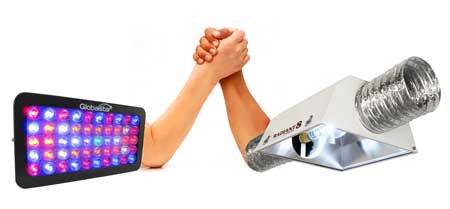Can LED Grow Lights Replace Traditional HPS Setups In 2019?

If you are a cannabis grower or are thinking about starting to grow cannabis, then you've come across loads of marketing for LED grow lights on the internet. When it comes to the truth about LED grow lights until recently it's been hard to distinguish the facts from fictions.
When manufacturers developed early LEDs and tried to market them to a skeptical audience of experienced growers some deceiving marketing claims were just the ticket to muddy up the waters of belief just enough to get people to buy their crappy early LEDs. With no thought to the future, they started manipulating data to sell their products.
Claim #1 / Busted: A watt isn't always a watt, What?
Manufacturers naturally wanted to build a level playing field between their new fancy LEDs and the old faithful HPS systems. They did this by “creating” an estimated wattage rating to equate the power a LED was producing to that of what an HPS was producing. So, an LED manufacturer would claim their 400-watt LED panel produced the same power light as their 400-watt HPS counterpart. This wasn't true at all, and for one huge reason.
There is no correlation between watts and the light produced by an LED. The light generated by LED's is very different from traditional incandescent lights whereas a bulb delivers 400-watts of light because it converts 400-watts of electrical current into 400-watts of light energy. The light produced by an LED grow light is very different; it must be measured with a different unit of measurement. This is where the confusion begins.
How the power of LED is measured
As a consumer interested in LED horticultural technology you are going to need to learn a whole new way of thinking about light, and it's measured in metrics like PAR and PPFD. Say what? Metrics are a fancy word for measurements so don't let that throw you. PAR stands for photosynthetically active radiation and describes the visible spectrum between 400 nm and 700 nm. In other words, it is the sum of all the light that supports photosynthesis.
PPF or photosynthetic photon flux is light output from an LED per second.
PPFD or photosynthetic photon flux density describes the light intensity generated by an LED on a plants surface per second.
So, what does all this mean?
Don't get caught up buying cheap LED units that promise to be a wattage replacement for an HPS light, for example, an LED rated at 400-watts is not a replacement for a 400-watt HPS.
Claim #2 / Proven True: Will I recoup my higher up-front investment in an LED?
A good quality true full spectrum or wideband spectrum LED grow light is going to cost about 30% more than its HPS counterpart up front. Now, where do the savings come in? Well, they are two-fold, firstly HPS bulbs are about 30 bucks a pop and need to be replaced every 3 to 4 grows. That's more investment whereas LED's routinely are rated for 100,000 additional hours of maintenance-free operation.
Where LED really starts to make back their upfront investment is with your electricity bill. The savings of operating a LED over an equivalent HPS is staggering. The LED will use about 30 to 35% less electricity to produce the same effect as an HPS lamp. So, every grow you make with your LED recoups more of your initial higher investment. You can't really invest in a better technology option for this single reason.
Claim #3 / Busted: All LED grow light products are basically the same?
A few years back when LED within its early development stages the only financially feasible option for LED makes was to produce just two-color chips, red and blue. Why not, plants react most to light in these two spectrums. But with time came to research and it was found that those purple colored LED lights left the plants lacking many light spectrums that are needed for proper healthy growth.
Since then new designs like COBs and Wideband diodes have become available on the market but still cost a premium. More modern lights include near-red and infrared wavelengths which trigger better growth. Cobs are a powerful, penetrating option that is great for getting light deep into a canopy. Cob or “chips on board” Any light you consider buying should include either COB or wideband technology because they are the best current technologies available.
So can you replace your HPS grow lights with LEDs?
I've been growing medicinal cannabis for ten years and have used LED exclusively for the past three years. I was forced to make the jump early because electricity prices in my area are extremely high and without the energy savings of LED technology my cost per gram would have gone way up over time.
If you have the money, pay for the best LED that you can get. Invest now because you'll be using that light for years to come, it won't break or burn out, it just keeps growing cannabis crop after crop.
Find more information on budsgrowguide.com.
839GYLCCC1992




Leave a Reply